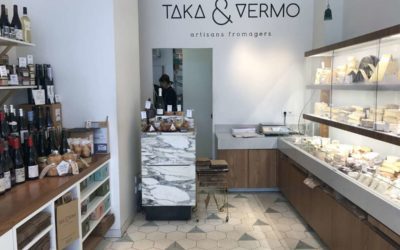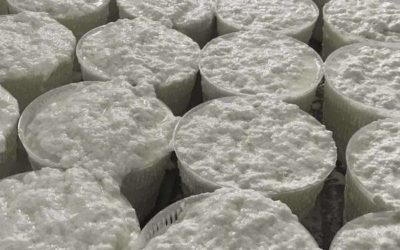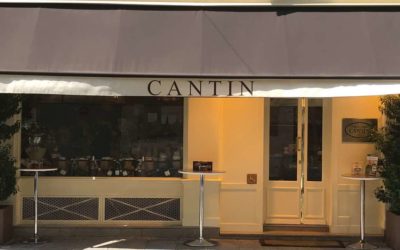Cheeses With Weird Names
For thousands of years, working in harmony with animals and Mother Nature, the man has been producing a precious product: cheese. Proud of and wanting to honor his creations, he gave them graceful, poetic and expressive names. Clacbictou (Slapgoat), Crottin (Animal Dung), Vieux Puant (Old Smelly), Trou du cru (Butt Hole)… Let’s look into it.

There are more than 1300 cheeses in France so we won’t take a look at each one but, on the whole, we can divide the names of cheeses into five categories: the names of origin, the visual names, the historical names, the dialectal names and the gross names.
The Names of Origin
The majority of cheeses have names that represent where they were originally produced – this is an easy one.
A couple of examples: Valençay comes from the village of Valençay, Cantal comes from the Cantal area of the Auvergne region, Comté comes from the Franche-Comté region, and so on and so forth… Cheese names can also come from local geographical landmarks, like Mont d’Or of the mountain of the same name, which literally means the Golden Mountain. There are also compound names, like Ossau-Iraty, which can be produced in the Ossau Valley in the Pyrenees, but also in the forested region of Iraty on the border of France and Spain.

The Visual Names
Some names refer to the cheese’s shape: the Bûchette du Bois-Rond, which translates to the Small Log of Bois-Rond (in the shape of a small, wood log), the Pavé d’Auge or Auge’s Cobblestone (in the shape of a cobblestone), the Carré de l’Est, which means The Square of the East (in the shape of a square), the Boule de Lille, also known as Mimolette, meaning the Ball from Lille (in the shape of a ball), the Brique du Forez, which translates to the Brick of Forez (in the shape of a brick)… okay, you get the idea…

The Historic Names
Some examples :
Roquefort
In the 5th century CE, the Heathens were wont to burn, rape and pillage, making it difficult to live in Aveyron in Southern France, or anywhere else for that matter. A small village of ferocious and steadfast Aveyronian shepherds decided to fight back by fortifying their village, which consequently became known as Roca forta in Latin, meaning The Fortress. The name of the village morphed into Roquefort, then Roquefort-sur-Soulzon. The cheese originating from this village inherited its name.

Munster
In the 7th century CE, Italian Benedictine monks moved into the Fecht Valley in Eastern France and build a monastery in honor of Saint Gregory. The surrounding area came to be called the Valley of Saint Gregory, then the Munster Valley, from the latin monasterium, or monastery. The monks made a washed rind cheese at the monastery which was baptised with the same name.
La cervelle de Canut, or Canut’s Brain
It’s not a brain but a local specialty from the southeastern French city of Lyon: fresh, soft cheese, also known as fromage blanc, mixed with chives and herbs. This kind of cheese was cheap to make and rich in protein; essentially what the poor ate. And the poor in 19th century Lyon were the silk weavers, also known as “canuts.” The “brain” of Canuts’ Brain is in reference to the shape of the cheese.
The Dialectal Names
Reblochon
This word comes from the verb “re-blocher” in the dialect of the Savoy region, literally meaning “to pinch again,” as in “to milk a second time.” Back then farmers were taxed on their milk production, so they would milk a first time while the inspector was watching, then a second time in secret to make Reblochon, or “Second Milking!”
Le Chabichou du Poitou, Chavignol and others
This name derives from the arabic chebli, which means “small goat.” In their conquest of land, the Moors raided and conquered the Poitou-Charentes and Limousin regions of France in the 8th century CE. Some of the Moors decided to settle in their newly occupied land, began making goat cheese and taught the local population their techniques — hence the name Chabichou of Poitou.

The Pélardon
The name Pélardon comes from “pebre” in the old Occitan dialect, meaning “pepper.” The Pélardon is a smal, round, flat cheese made in the South-Central mountainous region of Cévennes which has a spicy and peppery taste.
The Gross Names!
Le vieux puant (also known as vieux Lille, gris de Lille), or Old Stinky (or Old Lille, or The Drunk of Lille).
This cheese is a mutant Maroilles. The French cheese Maroilles, as is, already makes you wrinkle your nose. So now take a Maroilles and soak it in salt water for three long months. Now you’ve got a good and stinky Vieux Lille.
The cacouyard or shit balls
This name is born of the verb “cacouyer,” meaning “to stir or mix cheese” in the old Franc-comtois dialect of the Franche-Comté region. The name in French has a nice ring to it: Shit Balls.
Le trou du cru or Butthole
Yes, okay, sometimes cheese smells bad but it’s not what you think…
The “trou de cru,” which literally means the “hole in the raw,” is actually a byproduct of making Époisses cheese. Since it was difficult to get Époisses to age consistently all the way to the center of the cheese, the center was removed while it was still somewhat raw — that is to say not aged. Quite simply, they made hole in the raw cheese. In French, however, the name sounds almost identical to “butt hole.”
Le crottin de chavignol, or The Poop of Chavignol
The Poop of Chavignol got its name from the term “crot” of the central Berry region of France, which refers to the river bank where, back in the day, women used to wash laundry. The clay along the river was used by peasants, first for oil lamps, then as molds to drain cheese curd. “Crot” gave way to “crottin,” the container giving its name to the contents. In French, however, “crot” sounds pretty similar to the word for poop…
There are other names that seem to have fallen from the sky. That’s because they make people laugh and it sells: le téton de Saint-Agathe or Saint-Agathe’s Titty, le bouton de culotte or the Painties’ Button, la boule des moines or The Monks’ One Ball…
You see, French people can be creative!

The last CheeseNews
La fromagerie Taka&Vermo : the most vivid cheese shop in Paris
Quelques mois après s’être rencontrés, Mathieu et Laure décident de créer un projet commun autour de leur amour pour les produits laitiers. C’est ainsi qu’après un Tour de France des fromages à la rencontre des petits producteurs, la fromagerie Taka & Vermo voit le jour.
Le tour de fromage
Better than Le Tour de France, le Tour de Fromage 🙂 Let’s discover French cheese regions one cheese at a time.
Have a nice trip !
La fromagerie Marie Anne Cantin : the most authentic cheese shop in Paris!
Fromagerie Cantin has opened in 1950, originally created by Marie-Anne Cantin’s parents. As a child, she enjoyed selling cheeses and when she turned 25, Marie-Anne took over the family business.





